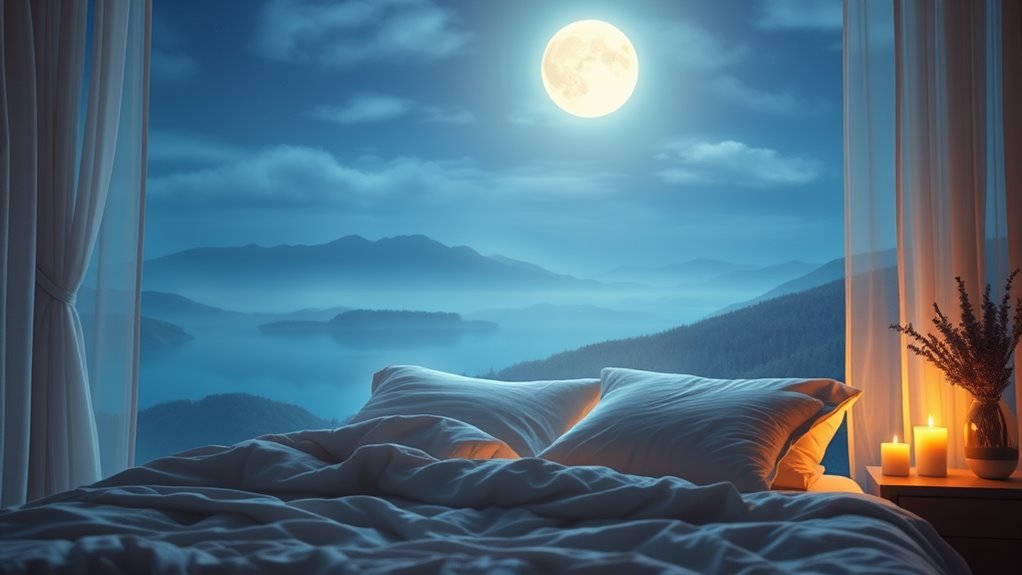Achieve Deep Sleep Instantly With Our Sleep Visualizations!
Achieving deep sleep instantly is possible with sleep visualizations! By guiding your mind into a restful state, you can escape distractions and stress. These techniques help you relax, paving the way for more restorative sleep. You’ll not only experience deeper sleep cycles but also wake up refreshed and energized. As you explore these powerful tools, you’ll discover effective methods tailored to your unique needs. Stay tuned to learn more about maximizing your sleep quality!
Key Takeaways
- Utilize immersive guided imagery to create a serene mental space that promotes relaxation and eases you into deep sleep quickly.
- Focus on sensory details during visualizations to help distract your mind from external stressors and achieve instant calmness.
- Set a consistent sleep routine and environment free from distractions to enhance the effectiveness of sleep visualizations for deeper rest.
- Incorporate relaxation techniques, such as deep breathing or mindfulness, to augment the benefits of visualizations and facilitate rapid deep sleep.
- Regularly track and adjust your visualization practices based on personal insights to maximize their impact on achieving deep sleep instantly.
Understanding Sleep Visualizations
When you look at sleep visualizations, you’re really revealing a powerful tool for understanding your sleep patterns.
These visual tools help you analyze how different factors influence your ability to sleep deep. By mapping your sleep cycles, you can pinpoint disturbances and identify triggers that prevent restorative rest.
As you explore deeper into your sleep data, you’ll gain insights into when you achieve your most rejuvenating sleep.
Incorporating visualization techniques can significantly enhance your ability to calm your mind and prepare for sleep.
This mastery over your patterns can empower you to make strategic changes, whether it’s adjusting your bedtime routine or creating a more conducive sleep environment.
Ultimately, sleep visualizations become a guide, helping you refine your approach and enhance your overall sleep quality, enabling you to embrace deeper, more fulfilling rest.
The Science Behind Deep Sleep
Understanding sleep visualizations not only highlights your patterns but also sets the stage for grasping the science behind deep sleep.
Deep sleep, or slow-wave sleep, plays an essential role in your overall well-being. Here’s what you should know:
-
It’s the phase where your body repairs muscles and tissues.
-
Your brain clears out toxins accumulated during the day.
-
Growth hormone releases peak, aiding in cellular regeneration.
-
Memory consolidation occurs, enhancing learning and retention.
-
Incorporating sleep visualizations into your routine can significantly enhance your ability to reach deep sleep more effectively.
Benefits of Sleep Visualizations
Sleep visualizations can greatly enhance your relaxation techniques, making it easier to unwind at the end of the day. By incorporating these techniques, you’ll likely notice improved sleep quality and a greater ability to manage stress. Additionally, engaging in immersive mental imagery can promote a deeper state of relaxation, leading to restorative sleep. Let’s explore how these benefits can transform your nightly routine.
Enhanced Relaxation Techniques
While you may often find it challenging to unwind after a long day, incorporating sleep visualizations can greatly enhance your relaxation techniques. By engaging your imagination, you can markedly lower stress levels and foster a sense of peace.
-
Immerse yourself in serene landscapes, allowing your mind to disconnect.
-
Focus on your breath, syncing it with the visuals to anchor your thoughts.
-
Use guided imagery to evoke calmness and creativity, paving the way for tranquility.
-
Visualize success and comfort, transforming anxiety into reassurance.
These practices not only help you detach from daily stresses but also train your mind to settle into a restful state, enhancing your overall relaxation experience.
Embrace these techniques to master your unwinding process.
Improved Sleep Quality
When you incorporate sleep visualizations into your nightly routine, you’ll likely notice a remarkable improvement in your sleep quality. These mental images guide your mind away from daily distractions, allowing for a seamless shift into restorative sleep.
As you visualize serene landscapes or calming scenarios, your brain begins to associate these soothing images with relaxation, enhancing your ability to fall asleep swiftly and effortlessly.
With consistent practice, you’ll experience deeper sleep cycles, allowing your body to repair and rejuvenate effectively.
Visualizations can even help you maintain longer periods of uninterrupted rest, resulting in increased energy levels and heightened focus during the day.
Stress Reduction Benefits
As you integrate sleep visualizations into your routine, you’ll find that stress reduction becomes a natural byproduct. By honing your mental imagery skills, you’re not just enhancing your sleep but also cultivating a more relaxed mindset throughout the day.
- Experience heightened relaxation during sleep onset
- Reduce anxiety levels through calming visualizations
- Improve resilience against daily stressors
- Foster a more peaceful, focused mind
These benefits compound over time, allowing you to deepen your understanding of your stressors and respond to them more effectively.
Embracing sleep visualizations empowers you to transform your nights into a sanctuary of tranquility and your days into vibrant, stress-free experiences. Mastering this technique can greatly elevate your overall well-being.
Preparing Your Sleep Environment
To get the best night’s sleep, you need to create an inviting sleep environment. Start by setting the ideal room temperature, dimming the lights, and using noise reduction techniques. These simple adjustments can greatly enhance your sleep quality. Incorporating nighttime visualization techniques can also help you relax and prepare your mind for restful sleep.
Optimal Room Temperature
Ensuring your bedroom’s temperature is just right can markedly impact your sleep quality. The ideal temperature typically ranges between 60°F to 67°F (15°C to 19°C). A cool environment helps lower your body’s core temperature, signaling it’s time to rest.
To optimize your sleep atmosphere, consider these tips:
- Choose breathable bedding and pajamas.
- Use a fan or air conditioner to maintain the desired temperature.
- Keep windows open for fresh air, if weather permits.
- Experiment with blankets to regulate warmth.
Dimming the Lights
When you dim the lights in your bedroom, you signal to your body that it’s time to wind down. This simple act not only sets the mood but also encourages your mind to shift into a state conducive to rest.
As darkness envelops your space, your body’s production of melatonin increases, promoting deeper sleep. Consider using dimmable lights or lamps to create a calming atmosphere. Additionally, opt for warm hues instead of harsh whites—these softer tones enhance relaxation.
Aim to lower the intensity at least 30 minutes before bed, allowing your body ample time to adjust. By mastering your light environment, you cultivate a sanctuary for sleep and prepare yourself for a night of rejuvenating rest.
Noise Reduction Techniques
Creating a peaceful sleep environment often starts with minimizing noise.
To truly master your sleep sanctuary, consider these effective noise reduction techniques:
-
Invest in soundproofing: Use heavy curtains or acoustic panels to dampen external sounds.
-
Employ white noise machines: These devices can mask disruptive noises, creating a consistent auditory backdrop.
-
Seal gaps in windows and doors: Verify no sound creeps in by using weather stripping or door sweeps.
-
Opt for calming sounds: If silence feels too stark, try nature sounds or soft music to encourage relaxation.
Techniques for Effective Visualization
Effective visualization techniques can transform your understanding of sleep patterns and enhance overall well-being.
To master visualization, begin by creating a serene mental space—imagine a peaceful scene where you feel completely at ease. Focus on sensory details, such as the gentle sound of waves or the scent of fresh pine, to immerse yourself in the experience.
Practice regularly, ideally at bedtime, to reinforce these calming images in your mind. Incorporate deep breathing to synchronize your thoughts and relaxation; inhale deeply as you visualize and exhale any tension. Additionally, utilizing relaxation techniques can further amplify the effectiveness of your sleep visualizations.
Guided Sleep Visualization Exercises
Building on the calming techniques you’ve practiced, guided sleep visualization exercises can take your mental relaxation to the next level.
These exercises invite you to immerse yourself in serene scenarios, easing your shift into sleep.
Consider integrating the following elements into your practice:
- Engaging Imagery: Picture tranquil landscapes, like a quiet beach at sunset.
- Breath Focus: Synchronize your breath with the rhythm of the visualization.
- Positive Affirmations: Use calming phrases to reinforce relaxation as you drift off.
- Tension Release: Visualize letting go of stress with each exhale, creating space for peace.
Through these methods, you’ll craft an inviting mental space, making sleep more accessible and profound.
Overcoming Common Sleep Barriers
While many desire a restful night’s sleep, several common barriers can hinder your journey to rejuvenation. Identifying these barriers is the first step towards mastery of your rest.
| Barrier | Effect on Sleep | Solution |
|---|---|---|
| Stress | Prevents relaxation | Meditative techniques |
| Noise | Disrupts deep sleep | White noise machines |
| Screen Time | Impairs melatonin production | Set a device curfew |
| Uncomfortable Bed | Causes restlessness | Invest in quality bedding |
| Irregular Schedule | Disrupts sleep cycle | Establish a consistent routine |
Incorporating Sleep Visualizations Into Your Routine
As you prepare for sleep, incorporating visualizations can create a calming atmosphere that guides your mind toward relaxation. To master this technique, try these steps:
-
Choose a quiet environment****: Find a space free from noise and distractions to enhance your focus.
-
Select a visualization theme****: Picture serene landscapes, peaceful oceans, or soft clouds to ease your mind.
-
Engage your senses: Imagine the sounds, scents, and textures within your visualization to deepen the experience.
-
Practice regularly: Dedicate time nightly for your visualizations, allowing the practice to become an integral part of your routine.
Tracking Your Progress and Improvements
Tracking your progress and improvements in sleep visualizations can greatly boost their effectiveness. By monitoring your sleep quality and visualization practices, you can identify what works best for you. Establish a routine for recording your insights, and don’t hesitate to adjust as necessary. Use the table below to log your findings regularly:
| Date | Duration (mins) | Sleep Quality (1-10) |
|---|---|---|
| 2023-10-01 | 20 | 7 |
| 2023-10-02 | 25 | 8 |
| 2023-10-03 | 30 | 9 |
| 2023-10-04 | 20 | 6 |
| 2023-10-05 | 25 | 8 |
Frequently Asked Questions
Can Sleep Visualizations Be Used by Children as Well?
Sleep visualizations can benefit children too. Isn’t it amazing how guiding their imagination can create a calming nighttime routine? You’ll find they drift off easier and wake up refreshed, fostering healthy sleep habits.
How Often Should I Practice Sleep Visualizations for Best Results?
To achieve ideal results, practice sleep visualizations nightly. Consistency is key; the more you integrate this technique into your routine, the more effective it’ll become, helping you master the art of relaxation and deep sleep.
Are There Any Age Restrictions for Using Sleep Visualization Techniques?
There aren’t any strict age restrictions on sleep visualization techniques; both young minds and seasoned spirits can benefit. However, tailoring the approach for different ages enhances effectiveness, ensuring everyone reaps the full rewards of deep restorative sleep.
Can Sleep Visualizations Help With Anxiety or Stress Relief?
Yes, sleep visualizations can greatly reduce anxiety and stress. You can visualize calming scenes to shift your focus, quiet racing thoughts, and promote relaxation. This technique helps you gain control over your mental state and enhance well-being.
Is There a Specific Time of Day to Practice Sleep Visualizations?
You can practice sleep visualizations any time, but dedicating a few minutes before bedtime maximizes effectiveness. This routine helps you unwind, clearing your mind for deep relaxation and better sleep quality throughout the night.





